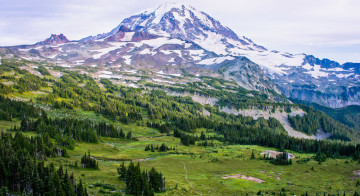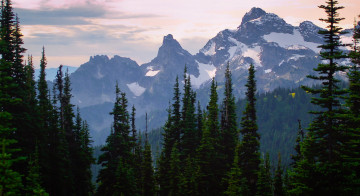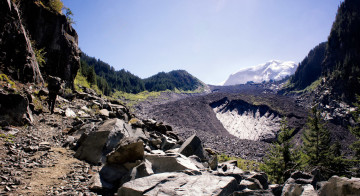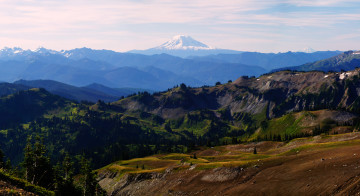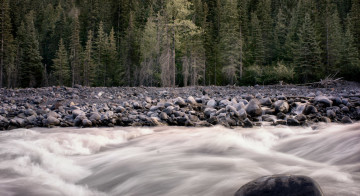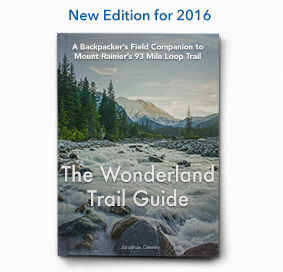Every year people die visiting Mount Rainier. Most of these deaths are climbing accidents that occur far beyond the reaches of the Wonderland Trail, but sometimes regular hikers get into trouble too. Many of the deaths involving hikers occur simply because people are unprepared for the fickle and often severe weather of the Cascades. Others occur because hikers are unprepared for navigation and get lost, and it's not hard to fall or twist an ankle when hiking off-trail (which makes getting home all the harder). Regardless of how these unforunate events unfold, the cause of death is nearly always the same: hypothermia. Fortunately hypothermia is something you can easily avoid if you take a few precaustions.
Always be prepared and have a plan for bad weather, hiking on snow, navigational challenges, injuries, fatigue, and not making your destination by nightfall. The final stories of hypothermia victims nearly always start with one of these situations.
Late summer and early autumn are typically the safest times to hike the Wonderland Trail. Be extra prepared for navigational challenges, river crossings, and bad weather if you’re hiking early or late in the season.
Hypothermia is your biggest danger. Most of the other wilderness dangers are getting into situations that precede hypothermia.
It's easy to ignore the initial symptoms of hypothermia because they're also easy to treat. Once a line has been crossed, however, hypothermia takes its victims quickly. Here are some general tips for avoiding, identifying, and treating hypothermia.
Avoiding hypothermia- Don’t wear cotton – only wear wool or synthetic fibers that can still insulate when wet.
- Make sure you always have a dry (and insulating) change of clothes. Keep some of your clothes in a waterproof bag for this purpose.
- Make sure your sleeping bag always stays dry, and use the utmost of care if you have a down bag (once down gets wet, there is no way you’ll be able to dry it by the time you need it).
- Make sure you drink enough liquids and that you’re getting enough to eat.
- Memorize this list of symptoms and and look for these in yourself and your hiking partners: Abnormal fatigue, confusion, slurred speech, clumsiness and shivering (which subsides as hypothermia worsens) are all symptoms of moderate to severe hypothermia.
- If for some reason you find yourself getting too cold and unable to warm up by adding layers of clothing, set up your tent, change into dry clothes and get into your sleeping bag. If you have a stove, drink some hot liquids. Fill up your water containers with hot water and place them in your sleeping bag.
Once hypothermia has become severe, chances of survival are slim without emergency medical care to actively rewarm the victim.
River crossings
Do you have a change of clothes and your sleeping bag stored in watertight bags?
Remember that a small creek may turn into an impassible torrent after a few minutes of heavy rain. Additionally, most of the rivers encountered on the Wonderland Trail can be impassible or dangerous to ford early in the summer when snowmelt is at its highest. If you're hiking along any route that crosses a river always check the latest trail conditions before you go. Bridges may not be in place early in the hiking season. Occasional debris flows can take out bridges later in the season, so never assume you'll be able to use them without checking trail conditions.
If you must ford a river, try to do so early in the morning before snow begins melting for the day.
When fording a river, look for calm water that is less than knee deep. Scout downstream and make sure that there’s a spot where you can likely pull yourself to shore if you fall and get swept downstream.
Unbuckle your pack so you can be prepared to slip out of it if you fall. Use hiking poles or two sticks, and wear water shoes or sandals so you have steady footing and don’t hurt your feet on the river bottom.
Never ford a river above dangerous rapids, a waterfall, or logs that could trap you. Angle your path so it’s slightly downstream. Most importantly, if you feel like the conditions are not safe, trust your instincts and wait, or find a safer place to cross.
Navigation
Do you actually know how to use that compass you've been hiking with for years? Being lost is not the time to learn.
Navigation on the Wonderland Trail is usually not an issue during peak hiking months, but it can be challenging whenever snow is encountered on the ground. It can also be a challenge in thick fog or bad weather. Areas of particular danger are the Panhandle Gap area, Spray Park, and Windy Gap on the Northern Loop Trail.
Knowledge of navigation by map and compass are mandatory before hiking in the wilderness. Additionally, it’s wise to bring a waterproof map and a durable GPS unit. Know how to use these devices before you get lost! This sounds like a no-brainer, but many people think they can figure it out if they get lost, and discover it’s more challenging to navigate than anticipated.
Never hike solo in the wilderness. A hiking partner is your strongest lifeline.
Research the area you’re visiting, know its dangers, and avoid hiking early or late in the season when snow is on the trail or bad weather is common.
Have a plan for being completely lost or unable to travel due to navigational mistakes, bad weather or injury. A good strategy we've probably all heard is to “hug a tree.” If you can, make camp in an exposed and safe location where you might be spotted by searchers from the air. On that note, try to avoid descending into valleys where you’ll be difficult to locate. Many lost hikers die in the Pacific NW when they attempt to follow rivers or streams downstream to their source. If you're ever so lost that you can imagine you're on the evening news, remember that some spotters in a helicopter will likely come to look for you first. You'll be a lot easier to spot on a ridge than in a valley.
If the weather is too bad for a helicopter to search for you, you need to realize that your greatest adversary is hypothermia. If you can't deal with this, you're toast (or more accurately, a popsicle). Otherwise, try to keep warm and dry, and stay put until ground searchers can find you.
It's critical to share your hiking plans with someone, and check-in with them as soon as you return. If you don’t return by an agreed-upon deadline, this person can report your absence to the park service. Otherwise it's just you and the marmots.
Share your plans: There is no check-out system for backpackers in the park, and the park service will not know to look for you if someone doesn’t report you missing.
Be aware of the dangers of hiking on snow
Trails can be difficult to see when they are obscured by snowpack. As the snow melts, it can erase marks left by other hikers. Trail markers can be buried under snow.
Hikers can get lost, fall through ice into creeks, or slip off of cliffs or down hillsides. Trees buried in deep snow sometimes form cavities of loose snow that can swallow hikers whole, not to be found until the summer thaw.
A common cause of death in the park is when a hiker slips and falls on a snowy slope. A fall on a slippery hillside can carry someone thousands of feet from the trail without hardly a trace. Even if someone survives an initial fall, they are often injured and unable to find help before dying of hypothermia. Many bodies remain hidden until the snow melts, and many more are never accounted for.
- Hike in-season to avoid snow at higher elevations. On the Wonderland Trail this is August and September. Use great care when hiking earlier or later in the year.
- Check with rangers for the latest updates on trail conditions.
- If you know that you’ll encounter patches of snow, use sturdy water-resistant footwear, keep a light backpack, use hiking poles, and plan for slower progress.
- Use care when hiking across steep slopes, and be aware that some hikers may have more difficulty maintaining their balance on the snow.
- Never hike over what appears to be a frozen creek or body of water, or over any area where you hear flowing water under the snow.
Know your physical limits
If you’re new to hiking or aren’t much of an athlete, limit your daily distance to around eight miles. Always give yourself more time to reach your destination than you think you need. This is particularly important if you’re day-hiking and light on the gear you need to safely spend the night in the woods. When you get tired, you’re more prone to injuries and falls. In the rugged landscape surrounding Mount Rainier a fall could turn into a serious emergency or worse, and the mountain weather can mean days before a search party can safely look for you.
Know how to perform basic wilderness first aid
For a starting point, Wikipedia has a good article on wilderness first aid. If you want a more comprehensive guide, I recommend picking up a copy of NOLS Wilderness First Aid (Nols Library).
Bring extra supplies
Bring more food than you need, carry extra water, and keep an extra set of dry clothes in a waterproof bag. Never hike without rain gear. Make sure you’ve always got the ten essentials.
The Ten Essentials
- Navigation – Topographic map, a compass, and a GPS receiver
- Sun protection – Sunglasses, sunscreen, a hat, and clothing for sun protection
- Insulation – Hat, gloves, jacket, extra clothes for the coldest weather you can expect in the season
- Illumination – An LED headlamp or flashlight and extra batteries
- A First-aid kit
- Fire – A butane lighter plus matches in a waterproof container
- Repair kit and tools – A multi-tool pocket knife with pliers, duct tape, cable ties, and a shovel
- Nutrition – Carry extra food for one additional day.
- Hydration – 2 liters per day plus a method for water purification
- Emergency shelter – Bring a tarp or bivy sack and an insulated sleeping pad
Safety around wild animals of Washington State
Wildlife generally poses little threat to visitors in the Cascades and Olympics. In the Cascades you are likely to encounter mountain goats, black bears, elk and black-tailed deer. If you exercise caution and respect, these encounters will likely be nothing more than pleasant experiences. As a hiker in North America, however, you should know how to act when encounters with some of the wildlife gets too close for comfort. We'll cover the basics here.
Dealing with not-so-great wildlife encounters
Black bears
(They don't like surprises)
Black bears attacks are extremely rare in the United States, but can occur if you surprise or make a bear feel threatened.
If you see a bear before it sees you, make some noise to alert it of your presence. Bears have poor eyesight and can be startled if you get too close.
If you find yourself facing a bear on the trail, back away and give it time to leave – especially if you see cubs. Here is a thorough article on black bear safety from WSU.
Never feed bears. This means not leaving food unattended. If a bear steals your food, it means that you've just given bear a great lesson on the deliciousness of robbing humans.
Mountain lions
(no running)
Mountain lions are hardly worth mentioning here due to the fact they rarely attack anyone in the United States. Since I don't want to let down a subset of readers here who may have grown up on Chuck Norris flicks, I have included some brief instructions on dealing with an aggressive cougar: It is rare to see a mountain lion in the wilderness as they are stealthy creatures that like to keep their distance until they are moving in for the kill. With this thought fresh in our minds, let's move to the next point: If you do see a cougar, back away slowly (do not run or turn your back to the lion). Hold any small children and keep larger kids close. If you're in a group, a mountain lion is most likely stalking one of the smaller members. If a cougar approaches you, wave your arms, yell, throw things and try to look larger than you actually are.
While attacks on humans are a very unlikely occurrence (especially in Washington State), if you or a hiking partner is attacked by a cougar, realize this is a deathmatch that will probably not unfold like the time you were accosted by your neighbor's ill-behaved pomeranian. Fight with everything you have and guard your neck and head. Mountain lions will typically focus on one target, and may return again for this same target, even after you’ve repelled an initial attack. When mountain lions attack, they are vicious and determined, and you may need to severely injure or even kill the cougar to end the attack on your terms. On that uplifting note, let’s imagine you victoriously beating the attacking cougar to death with a rock and then move along to herbivores…
Mountain goats, elk, and deer
(tl;dr, goats are jerks, deer can be thieves)
Mountain goats can sometimes be aggressive. Goats are responsible for nearly all of my not-so-great wildlife experiences when backpacking. Don’t get too close. Goats can be curious, territorial, and bold. They are often indifferent to your presence. They sometimes try to give passers-by a good knock. Always give goats the right-of-way on a trail. Use particular care if you are near them on a steep slope. Trying to scare one out of your way can provoke a duel, which is not a desirable situation. Moving outside of the spook radius is usually enough to satisfy an aggressive goat. In my (bad) experiences, they tend be most interested in seeing you hit the road, and don't a perceived threat far from the herd. If your way is blocked by a herd of goats and feel like you're passing close enough to incite aggressive posturing, back off and enjoy some trail mix and iodine water until the goats move along.
The same treatment applies to elk and deer, although they tend to be skittish creatures. In particular, elk and deer can be territorial if you get too close during the fall rut and it’s best to not approach them.
In some places, deer have grown to be unafraid of humans and try to steal from campers. This is true for some of the deer that live around around the popular tourist attraction of Hurricane Ridge in Olympic National Park. Overly charismatic deer can be maddening to deal with for backcountry hikers, unlike the car tourists who train the deer. If a deer is making strafing runs on your campsite don't hesitate to make loud noises and try to scare it off. More importantly, don't leave food unattended and contribute to the problem.
Avoid conflicts by protecting food and scented goods
Mice, black bears, and everything in-between will be attracted to unattended food or scented items.
Keep your food and scented goods hanging or in a bear-proof canister when in camp unless you are eating. Never leave food or scented items in a tent or unattended. When you leave your empty backpack outside of the tent, be sure to unzip all of your pockets, or be prepared to find holes chewed through to wherever you stored that Cliff Bar or bag of trail-mix earlier in the day.
Additional resources:
Hiking Safety – Mount Rainier National Park
Six Tips to Stay Safe in the Wilderness
